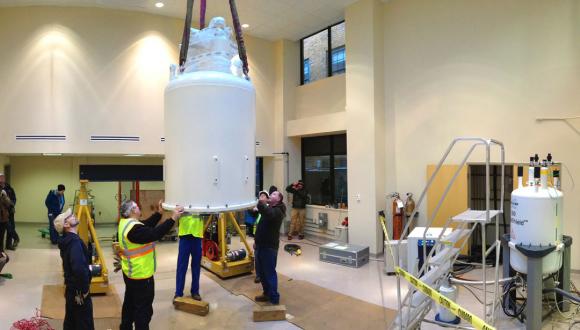PROVIDENCE, R.I. [Brown University] — The magnetic field strength is what really matters about Brown’s new Bruker 850 nuclear magnetic resonance spectrometer, but from a visceral standpoint here’s an impressive attribute: It’s so big that delivery today at the Laboratories for Molecular Medicine required lowering it with a crane through a 100-square-foot portal in the roof of the building at 70 Ship St.
“That’s the only way into the building,” said medicine and chemistry Professor Wolfgang Peti. “No door is large enough.”
Elbow Street was closed most of the day to host the crane and the tractor-trailer that hauled the humongous magnet here. It’s about 13 feet tall and nearly five feet in diameter. It weighs more than 7,700 pounds.
But much greater than the $2.9-million magnet itself is the potential of the research it will enable. Its job is to provide the incredibly strong magnetic field used in NMR spectroscopy. The technology allows chemists and biologists to determine the structure and motions of proteins down to the level of their individual atoms. It’s a powerful tool for observing the most fundamental workings of life.
The new magnet’s field strength of 19.97 Tesla vastly exceeds the University’s current NMR spectroscopy magnet, which has a strength of 11.7 Tesla. That means the new instrument will have higher resolution, Peti said. It will be able to produce distinct information from signals that the weaker magnet would have represented as overlapping, and will be able to measure distances of as small as 2 Angstroms (two tenths of a billionth of a meter).
“We can now look at larger biomacromolecules, such as proteins or protein-DNA and protein-RNA complexes,” Peti said. “We have done those kind of measurements at Brandeis University for the last seven years.”
Brown University Provost Mark Schlissel said the magnet is an important investment in research. “In many fields of science, discovery is limited not by creative ideas but rather by access to cutting-edge tools such as the 850 MHz spectrometer now being installed,” Schlissel said. “In this case, anonymous donors who share our vision of enhancing Brown’s impact on society through research provided the resources that allowed my office to support this critical acquisition.”
Brown will now have the second most powerful NMR capability in New England, behind an instrument shared by Harvard and MIT. There are only a few comparable spectrometers in all of the northeast, including the mid-Atlantic region.
It will be installed alongside its smaller, older 11.7-Tesla brother in the Structural Biology Core Facility on the building’s first floor.
The most frequent users are likely to be the University’s core structural biology faculty members: Peti, Gerwald Jogl, Rebecca Page, and Nicolas Fawzi. The search for another junior colleague is underway.
But with full-time, expert facility manager Michael “Sparky” Clarkson on board, Peti said, other faculty members will have expert help using the NMR tools.
The core facility is also available for use beyond Brown, Peti added. The new magnet already has stirred interest among pharmacy researchers at the University of Rhode Island, and universities in the area are cooperating to apply for a grant for a third, mid-range magnet.
Now that the magnet has been loaded in, work on the facility continues and the magnet will be fully installed by spring. Peti already has plans for the new instrument’s capabilities.
He has a hypothesis about how enzymes called MAP kinases are activated in the body. These proteins are responsible for regulating cell functions such as growth and inflammation. Problems in their activation or deactivation can result in terrible ailments such as cancer and Alzheimer’s disease.
“We think we’ve figured out how kinases get activated and we need to record some of the data here to prove our hypothesis,” he said.
Now Brown has a magnet big enough to observe those very tiny phenomena.

